

Compact Muon Solenoid
LHC, CERN
| CMS-PAS-B2G-21-001 | ||
| Search for Higgs boson pair production via vector boson fusion with highly Lorentz-boosted Higgs bosons in the four b quark final state at $\sqrt{s} = $ 13 TeV | ||
| CMS Collaboration | ||
| July 2021 | ||
| Abstract: Nonresonant Higgs boson pair production via vector boson fusion is searched for in the final state where each Higgs boson decays to a b quark-antiquark pair, and both Higgs bosons are highly Lorentz boosted so that they can be reconstructed as two large-radius jets. The data collected by the CMS experiment in 2016-2018 from proton-proton collisions at a centre-of-mass energy of 13 TeV is used, corresponding to an integrated luminosity of 138 fb$^{-1}$. A novel multivariate classifier based on graph neural networks, ParticleNet, is applied to identify the jets that contain the Higgs boson decay products. No excess is observed compared to the background-only expectation, and upper limits are set on the product of the nonresonant Higgs boson pair production cross section via vector boson fusion and the branching fraction into $\textrm{b}\bar{\textrm{b}}\textrm{b}\bar{\textrm{b}}$. The strength of the coupling between a pair of Higgs bosons and a pair of vector bosons relative to the standard model coupling is constrained within the range 0.6 $ < \kappa_{\textrm{2V}} < $ 1.4 at 95% confidence level when all other Higgs boson couplings are assumed equal to their standard model values. | ||
| Links: CDS record (PDF) ; CADI line (restricted) ; | ||
| Figures | |

png pdf |
Figure 1:
Leading-order diagrams for nonresonant HH production via vector boson fusion. |

png pdf |
Figure 1-a:
Leading-order diagrams for nonresonant HH production via vector boson fusion. |

png pdf |
Figure 1-b:
Leading-order diagrams for nonresonant HH production via vector boson fusion. |
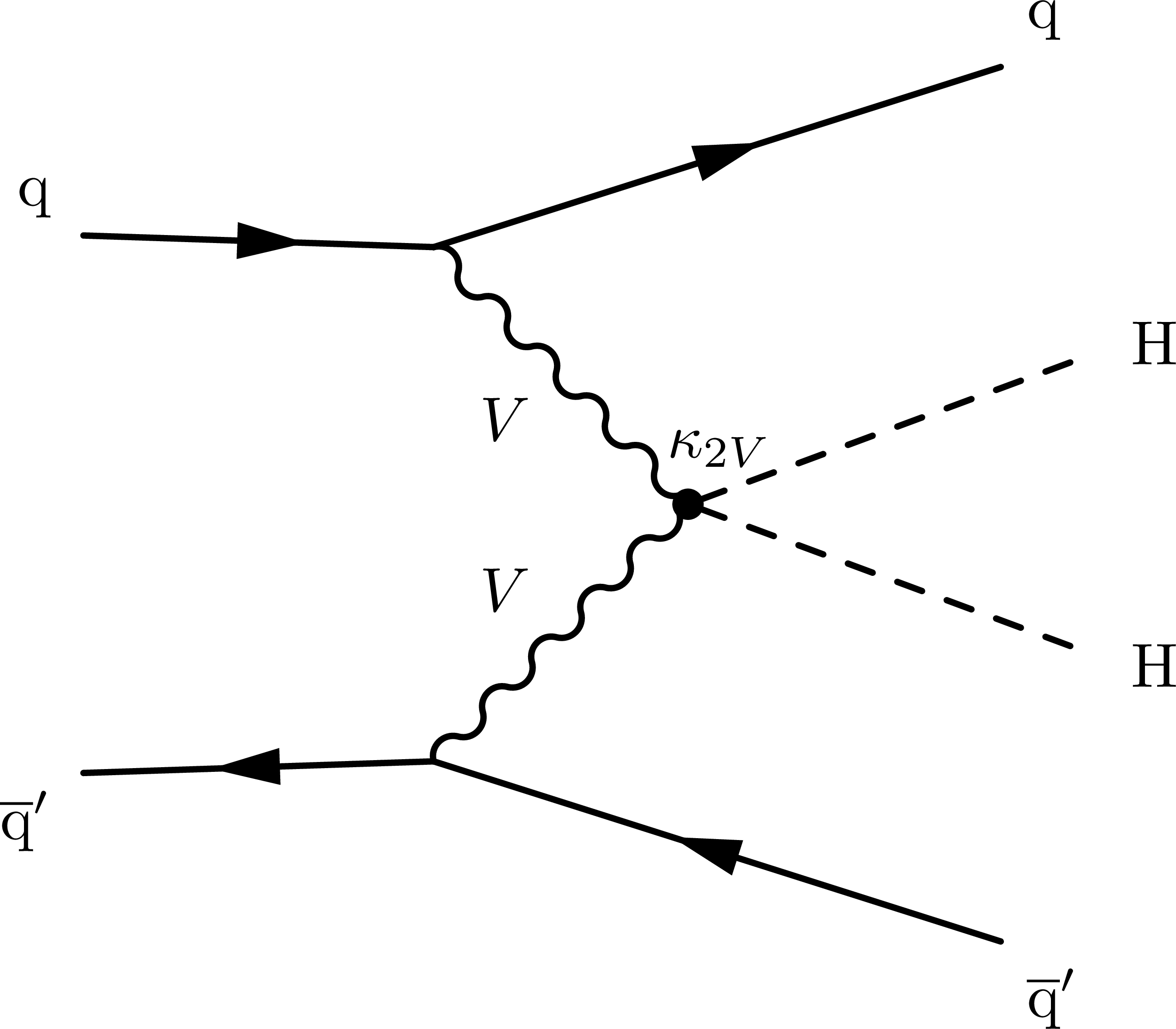
png pdf |
Figure 1-c:
Leading-order diagrams for nonresonant HH production via vector boson fusion. |
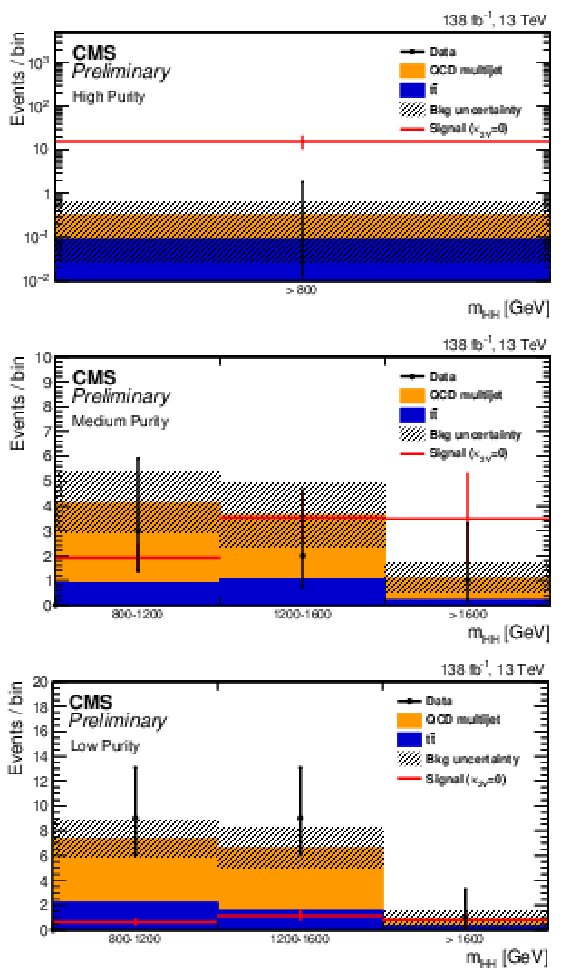
png pdf |
Figure 2:
The distributions of the invariant mass of the HH system after a background-only fit to the data, for the high-purity (upper), medium-purity (middle), and low-purity (lower) categories. |

png pdf |
Figure 2-a:
The distributions of the invariant mass of the HH system after a background-only fit to the data, for the high-purity (upper), medium-purity (middle), and low-purity (lower) categories. |

png pdf |
Figure 2-b:
The distributions of the invariant mass of the HH system after a background-only fit to the data, for the high-purity (upper), medium-purity (middle), and low-purity (lower) categories. |
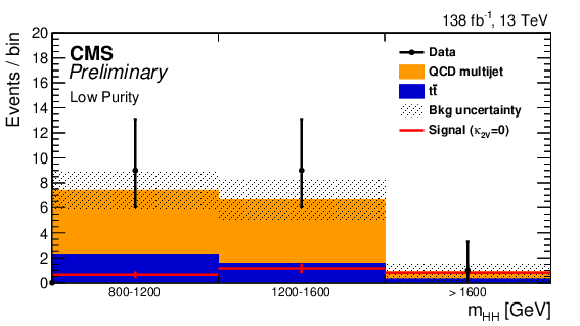
png pdf |
Figure 2-c:
The distributions of the invariant mass of the HH system after a background-only fit to the data, for the high-purity (upper), medium-purity (middle), and low-purity (lower) categories. |
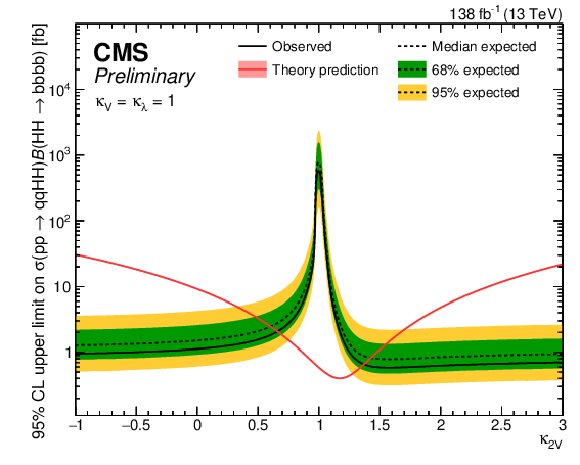
png pdf |
Figure 3:
Observed (solid line) and expected (dashed line) 95% CL exclusion limit on the product of the VBF HH production cross section and the branching fraction into ${\mathrm{b} \mathrm{\bar{b}} \mathrm{b} \mathrm{\bar{b}}}$, as a function of the ${\kappa _{\textrm {2V}}}$ coupling, with other couplings fixed to the SM values. The crossings of observed limit and the theoretical cross section (red line) indicate the ranges of the coupling values excluded at 95% CL. |
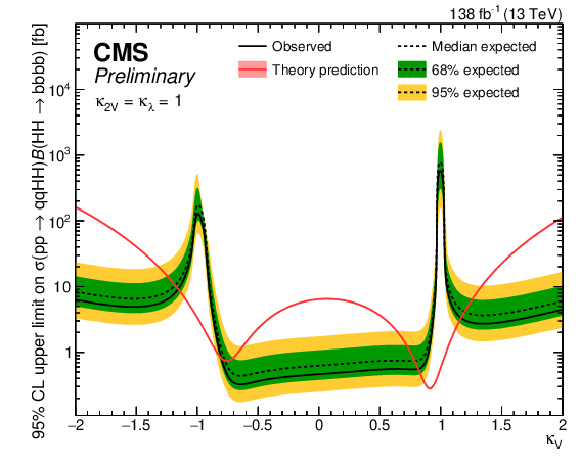
png pdf |
Figure 4:
Observed (solid line) and expected (dashed line) 95% CL exclusion limit on the product of the VBF HH production cross section and the branching fraction into ${\mathrm{b} \mathrm{\bar{b}} \mathrm{b} \mathrm{\bar{b}}}$, as a function of the ${\kappa _{\textrm {V}}}$ coupling, with other couplings fixed to the SM values. The crossings of observed limit and the theoretical cross section (red line) indicate the ranges of the coupling values excluded at 95% CL. |

png pdf |
Figure 5:
Observed (solid line) and expected (dashed line) 95% CL exclusion limit on the product of the VBF HH production cross section and the branching fraction into ${\mathrm{b} \mathrm{\bar{b}} \mathrm{b} \mathrm{\bar{b}}}$, as a function of the ${\kappa _{\textrm {2V}}}$ coupling, with the ${\kappa _{\textrm {V}}}$ coupling fixed to a values of 0.8 (upper) and 1.2 (lower), while other couplings are fixed to the SM values. The crossings of observed limit and the theoretical cross section (red line) indicate the ranges of the coupling values excluded at 95% CL. |

png pdf |
Figure 5-a:
Observed (solid line) and expected (dashed line) 95% CL exclusion limit on the product of the VBF HH production cross section and the branching fraction into ${\mathrm{b} \mathrm{\bar{b}} \mathrm{b} \mathrm{\bar{b}}}$, as a function of the ${\kappa _{\textrm {2V}}}$ coupling, with the ${\kappa _{\textrm {V}}}$ coupling fixed to a values of 0.8 (upper) and 1.2 (lower), while other couplings are fixed to the SM values. The crossings of observed limit and the theoretical cross section (red line) indicate the ranges of the coupling values excluded at 95% CL. |

png pdf |
Figure 5-b:
Observed (solid line) and expected (dashed line) 95% CL exclusion limit on the product of the VBF HH production cross section and the branching fraction into ${\mathrm{b} \mathrm{\bar{b}} \mathrm{b} \mathrm{\bar{b}}}$, as a function of the ${\kappa _{\textrm {2V}}}$ coupling, with the ${\kappa _{\textrm {V}}}$ coupling fixed to a values of 0.8 (upper) and 1.2 (lower), while other couplings are fixed to the SM values. The crossings of observed limit and the theoretical cross section (red line) indicate the ranges of the coupling values excluded at 95% CL. |
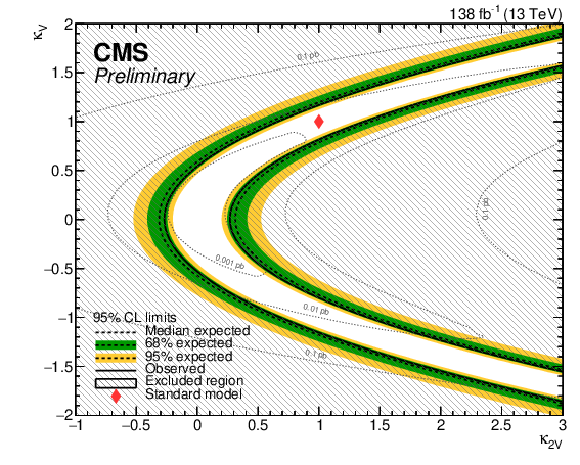
png pdf |
Figure 6:
Observed (solid lines) and expected (dashed lines) 95% CL exclusion limits as a function of the ${\kappa _{\textrm {2V}}}$ and ${\kappa _{\textrm {V}}}$ couplings, obtained with the CL$_{\text {s}}$ method, assuming all the other couplings to be fixed to the SM values. The hatched regions are excluded by the observed limits. The dotted curves indicate theoretical VBF HH production cross section predictions as a function of the two couplings. The SM prediction is shown as a red marker. |

png pdf |
Figure 7:
Observed values of likelihood as a function of the ${\kappa _{\textrm {2V}}}$ and ${\kappa _{\textrm {V}}}$ couplings, assuming all the other couplings to be fixed to the SM values. The dashed and dotted contours indicate the regions allowed at the 68 and 95% CL, respectively. The SM prediction is shown as a red marker. |
| Tables | |

png pdf |
Table 1:
Summary of selections that define the search region. |
| Summary |
| Nonresonant Higgs boson pair production via vector boson fusion is searched for in the final state where each Higgs boson decays to a b quark-antiquark pair, using data from proton-proton collisions at a centre-of-mass energy of 13 TeV, collected by the CMS experiment in 2016-2018 and corresponding to an integrated luminosity of 138 fb$^{-1}$. The analysis focuses on the phase space region where both Higgs bosons are highly Lorentz-boosted, so that the two Higgs boson decays can be reconstructed as two large-radius jets. The two large-radius jets with the highest transverse momentum are considered as the Higgs boson candidates. The analysis is the first one to target such boosted topology in search for nonresonant VBF {cmsSymbolFace{H}}hbbbb process, and the first one to apply a novel multivariate classifier based on graph convolutional neural networks, ParticleNet, to identify the jets that correspond to ${\textrm{H} \rightarrow \mathrm{ b\bar{b} }} $ decays. The data are found to agree with the background-only hypothesis, and upper limits on the production cross section are presented as a function of the coupling between a pair of Higgs bosons and a pair of vector bosons, ${\kappa_{\textrm{2V}}} $, and the coupling between one Higgs boson and a pair of vector bosons, ${\kappa_{\textrm{V}}} $, normalized to the coupling values predicted in the standard model. The observed (expected) limits constrain ${\kappa_{\textrm{2V}}} $ within the range 0.6 $ < {\kappa_{\textrm{2V}}} < $ 1.4 (0.6 $ < {\kappa_{\textrm{2V}}} < $ 1.4) and ${\kappa_{\textrm{V}}} $ within $-$1.2 $ < {\kappa_{\textrm{V}}} < $ $-$0.8 or 0.8 $ < {\kappa_{\textrm{V}}} < $ 1.2 ($-$1.2 $ < {\kappa_{\textrm{V}}} < $ $-$0.8 or 0.8 $ < {\kappa_{\textrm{V}}} < $ 1.2) at 95% confidence level, when all other Higgs boson couplings are assumed equal to their standard model values. The signal hypothesis with ${\kappa_{\textrm{2V}}} =$ 0 and other couplings equal to 1 is excluded at a CL higher than 99.99%. When both ${\kappa_{\textrm{2V}}} $ and ${\kappa_{\textrm{V}}} $ are varied simultaneously, the observed limits exclude the hypothesis ${\kappa_{\textrm{2V}}} =$ 0 at a CL of 95% or higher for all ${\kappa_{\textrm{V}}} $ coupling values above 0.5, with other couplings assumed equal to their standard model values. |
| References | ||||
| 1 | ATLAS Collaboration | Observation of a new particle in the search for the standard model Higgs boson with the ATLAS detector at the LHC | PLB 716 (2012) 1 | 1207.7214 |
| 2 | CMS Collaboration | Observation of a new boson at a mass of 125 GeV with the CMS experiment at the LHC | PLB 716 (2012) 30 | CMS-HIG-12-028 1207.7235 |
| 3 | ATLAS Collaboration | Search for Higgs boson pair production in the $ \gamma\gamma b\bar{b} $ final state using pp collision data at $ \sqrt{s}= $ 8 TeV from the ATLAS detector | PRL 114 (2015) 081802 | 1406.5053 |
| 4 | ATLAS Collaboration | Search for Higgs boson pair production in the $ b\bar{b}b\bar{b} $ final state from pp collisions at $ \sqrt{s} = $ 8 TeV with the ATLAS detector | EPJC 75 (2015) 412 | 1506.00285 |
| 5 | ATLAS Collaboration | Searches for higgs boson pair production in the $ hh\to bb\tau\tau, \gamma\gamma ww^*, \gamma\gamma bb, bbbb $ channels with the ATLAS detector | PRD 92 (2015) 092004 | 1509.04670 |
| 6 | CMS Collaboration | Search for two Higgs bosons in final states containing two photons and two bottom quarks in proton-proton collisions at 8 TeV | PRD 94 (2016) 052012 | CMS-HIG-13-032 1603.06896 |
| 7 | CMS Collaboration | Search for Higgs boson pair production in the $ \mathrm{b\bar{b}}\tau\tau $ final state in proton-proton collisions at $ \sqrt{s}= $ 8 TeV | PRD 96 (2017) 072004 | CMS-HIG-15-013 1707.00350 |
| 8 | ATLAS Collaboration | Search for pair production of Higgs bosons in the $ \mathrm{b\bar{b}}\mathrm{b\bar{b}} $ final state using proton--proton collisions at $ \sqrt{s} = $ 13 TeV with the ATLAS detector | PRD 94 (2016) 052002 | 1606.04782 |
| 9 | ATLAS Collaboration | Search for Higgs boson pair production in the $ \gamma\gamma b\bar{b} $ final state with 13 TeV pp collision data collected by the ATLAS experiment | JHEP 11 (2018) 040 | 1807.04873 |
| 10 | CMS Collaboration | Search for Higgs boson pair production in events with two bottom quarks and two tau leptons in proton--proton collisions at $ \sqrt s = $ 13 TeV | PLB 778 (2018) 101 | CMS-HIG-17-002 1707.02909 |
| 11 | CMS Collaboration | Search for resonant and nonresonant Higgs boson pair production in the $ \mathrm{b\bar{b}}\ell\nu\ell\nu $ final state in proton-proton collisions at $ \sqrt{s}= $ 13 TeV | JHEP 01 (2018) 054 | CMS-HIG-17-006 1708.04188 |
| 12 | CMS Collaboration | Search for Higgs boson pair production in the $ \gamma\gamma\mathrm{b\overline{b}} $ final state in pp collisions at $ \sqrt{s}= $ 13 TeV | PLB 788 (2019) 7 | CMS-HIG-17-008 1806.00408 |
| 13 | ATLAS Collaboration | Combination of searches for Higgs boson pairs in pp collisions at $ \sqrt{s} = $ 13 TeV with the ATLAS detector | PLB 800 (2020) 135103 | 1906.02025 |
| 14 | CMS Collaboration | Combination of searches for Higgs boson pair production in proton-proton collisions at $ \sqrt{s} = $ 13 TeV | PRL 122 (2019) 121803 | CMS-HIG-17-030 1811.09689 |
| 15 | F. A. Dreyer and A. Karlberg | Vector-boson fusion Higgs pair production at N$ ^3 $LO | PRD 98 (2018), no. 11, 114016 | 1811.07906 |
| 16 | CMS Collaboration | Combined Higgs boson production and decay measurements with up to 137 fb$ ^{-1} $ of proton-proton collision data at $ \sqrt{s} = $ 13 tev | CMS-PAS-HIG-19-005 | CMS-PAS-HIG-19-005 |
| 17 | F. Bishara, R. Contino, and J. Rojo | Higgs pair production in vector-boson fusion at the LHC and beyond | EPJC 77 (2017), no. 7, 481 | 1611.03860 |
| 18 | D. de Florian et al. | Handbook of LHC Higgs cross sections: 4. Deciphering the nature of the Higgs sector | CERN-2017-002-M | 1610.07922 |
| 19 | ATLAS Collaboration | Search for the $ HH \rightarrow b \bar{b} b \bar{b} $ process via vector-boson fusion production using proton-proton collisions at $ \sqrt{s} = $ 13 TeV with the ATLAS detector | JHEP 07 (2020) 108 | 2001.05178 |
| 20 | CMS Collaboration | Search for Higgs boson pair production in the four b quark final state | CMS-PAS-HIG-20-005 | CMS-PAS-HIG-20-005 |
| 21 | H. Qu and L. Gouskos | ParticleNet: Jet tagging via particle clouds | PRD 101 (2020) 056019 | 1902.08570 |
| 22 | CMS Collaboration | Identification of highly Lorentz-boosted heavy particles using graph neural networks and new mass decorrelation techniques | CDS | |
| 23 | CMS Collaboration | Mass regression of highly-boosted jets using graph neural networks | CMS-DP-2021-017 | |
| 24 | CMS Collaboration | Performance of the CMS Level-1 trigger in proton-proton collisions at $ \sqrt{s} = $ 13 TeV | JINST 15 (2020) P10017 | CMS-TRG-17-001 2006.10165 |
| 25 | CMS Collaboration | The CMS trigger system | JINST 12 (2017) P01020 | CMS-TRG-12-001 1609.02366 |
| 26 | CMS Collaboration | The CMS experiment at the CERN LHC | JINST 3 (2008) S08004 | CMS-00-001 |
| 27 | J. Alwall et al. | The automated computation of tree-level and next-to-leading order differential cross sections, and their matching to parton shower simulations | JHEP 07 (2014) 079 | 1405.0301 |
| 28 | P. Nason | A new method for combining NLO QCD with shower Monte Carlo algorithms | JHEP 11 (2004) 040 | hep-ph/0409146 |
| 29 | S. Frixione, P. Nason, and C. Oleari | Matching NLO QCD computations with parton shower simulations: the POWHEG method | JHEP 11 (2007) 070 | 0709.2092 |
| 30 | S. Alioli, P. Nason, C. Oleari, and E. Re | A general framework for implementing NLO calculations in shower Monte Carlo programs: the POWHEG BOX | JHEP 06 (2010) 043 | 1002.2581 |
| 31 | E. Bagnaschi, G. Degrassi, P. Slavich, and A. Vicini | Higgs production via gluon fusion in the POWHEG approach in the SM and in the MSSM | JHEP 02 (2012) 088 | 1111.2854 |
| 32 | M. Grazzini et al. | Higgs boson pair production at NNLO with top quark mass effects | JHEP 05 (2018) 059 | 1803.02463 |
| 33 | S. Dawson, S. Dittmaier, and M. Spira | Neutral Higgs boson pair production at hadron colliders: QCD corrections | PRD 58 (1998) 115012 | hep-ph/9805244 |
| 34 | S. Borowka et al. | Higgs boson pair production in gluon fusion at next-to-leading order with full top-quark mass dependence | PRL 117 (2016), no. 1, 012001 | 1604.06447 |
| 35 | J. Baglio et al. | Gluon fusion into Higgs pairs at NLO QCD and the top mass scheme | EPJC 79 (2019), no. 6, 459 | 1811.05692 |
| 36 | D. de Florian and J. Mazzitelli | Higgs boson pair production at next-to-next-to-leading order in QCD | PRL 111 (2013) 201801 | 1309.6594 |
| 37 | D. Y. Shao, C. S. Li, H. T. Li, and J. Wang | Threshold resummation effects in Higgs boson pair production at the LHC | JHEP 07 (2013) 169 | 1301.1245 |
| 38 | D. de Florian and J. Mazzitelli | Higgs pair production at next-to-next-to-leading logarithmic accuracy at the LHC | JHEP 09 (2015) 053 | 1505.07122 |
| 39 | T. Je\vzo et al. | An NLO+PS generator for $ \mathrm{t}\mathrm{\overline{t}} $ and Wt production and decay including non-resonant and interference effects | EPJC 76 (2016) 691 | 1607.04538 |
| 40 | S. Frixione, P. Nason, and G. Ridolfi | A positive-weight next-to-leading-order Monte Carlo for heavy flavour hadroproduction | JHEP 09 (2007) 126 | 0707.3088 |
| 41 | R. Frederix and S. Frixione | Merging meets matching in MC@NLO | JHEP 12 (2012) 061 | 1209.6215 |
| 42 | M. Czakon and A. Mitov | Top++: A program for the calculation of the top-pair cross-section at hadron colliders | CPC 185 (2014) 2930 | 1112.5675 |
| 43 | M. Czakon et al. | Top-pair production at the LHC through NNLO QCD and NLO EW | JHEP 10 (2017) 186 | 1705.04105 |
| 44 | NNPDF Collaboration | Unbiased global determination of parton distributions and their uncertainties at NNLO and at LO | NPB 855 (2012) 153 | 1107.2652 |
| 45 | NNPDF Collaboration | Parton distributions for the LHC Run II | JHEP 04 (2015) 040 | 1410.8849 |
| 46 | NNPDF Collaboration | Parton distributions from high-precision collider data | EPJC 77 (2017) 663 | 1706.00428 |
| 47 | S. Carrazza, J. I. Latorre, J. Rojo, and G. Watt | A compression algorithm for the combination of PDF sets | EPJC 75 (2015) 474 | 1504.06469 |
| 48 | J. Butterworth et al. | PDF4LHC recommendations for LHC Run II | JPG 43 (2016) 023001 | 1510.03865 |
| 49 | S. Dulat et al. | New parton distribution functions from a global analysis of quantum chromodynamics | PRD 93 (2016) 033006 | 1506.07443 |
| 50 | L. A. Harland-Lang, A. D. Martin, P. Motylinski, and R. S. Thorne | Parton distributions in the LHC era: MMHT 2014 PDFs | EPJC 75 (2015) 204 | 1412.3989 |
| 51 | T. Sjostrand et al. | An Introduction to PYTHIA 8.2 | CPC 191 (2015) 159--177 | 1410.3012 |
| 52 | CMS Collaboration | Event generator tunes obtained from underlying event and multiparton scattering measurements | EPJC 76 (2016) 155 | CMS-GEN-14-001 1512.00815 |
| 53 | CMS Collaboration | Investigations of the impact of the parton shower tuning in PYTHIA 8 in the modelling of $ \mathrm{t\overline{t}} $ at $ \sqrt{s}= $ 8 and 13 TeV | CMS-PAS-TOP-16-021 | CMS-PAS-TOP-16-021 |
| 54 | CMS Collaboration | Extraction and validation of a new set of CMS PYTHIA8 tunes from underlying-event measurements | EPJC 80 (2020) 4 | CMS-GEN-17-001 1903.12179 |
| 55 | GEANT4 Collaboration | GEANT4--a simulation toolkit | NIMA 506 (2003) 250--303 | |
| 56 | CMS Collaboration | Particle-flow reconstruction and global event description with the CMS detector | JINST 12 (2017) P10003 | CMS-PRF-14-001 1706.04965 |
| 57 | M. Cacciari, G. P. Salam, and G. Soyez | The anti-$ k_t $ jet clustering algorithm | JHEP 04 (2008) 063 | 0802.1189 |
| 58 | M. Cacciari, G. P. Salam, and G. Soyez | FastJet user manual | EPJC 72 (2012) 1896 | 1111.6097 |
| 59 | CMS Collaboration | Performance of electron reconstruction and selection with the CMS detector in proton-proton collisions at $ \sqrt{s} = $ 8 TeV | JINST 10 (2015) P06005 | CMS-EGM-13-001 1502.02701 |
| 60 | CMS Collaboration | Performance of the CMS muon detector and muon reconstruction with proton-proton collisions at $ \sqrt{s} = $ 13 TeV | JINST 13 (2018) P06015 | CMS-MUO-16-001 1804.04528 |
| 61 | CMS Collaboration | Jet energy scale and resolution in the CMS experiment in pp collisions at 8 TeV | JINST 12 (2017) P02014 | CMS-JME-13-004 1607.03663 |
| 62 | CMS Collaboration | Pileup mitigation at CMS in 13 TeV data | JINST 15 (2020) P09018 | CMS-JME-18-001 2003.00503 |
| 63 | D. Bertolini, P. Harris, M. Low, and N. Tran | Pileup Per Particle Identification | JHEP 10 (2014) 059 | 1407.6013 |
| 64 | CMS Collaboration | Performance of missing transverse momentum reconstruction in proton-proton collisions at $ \sqrt{s} = $ 13 TeV using the CMS detector | JINST 14 (2019), no. 07, P07004 | CMS-JME-17-001 1903.06078 |
| 65 | CMS Collaboration | Identification of heavy, energetic, hadronically decaying particles using machine-learning techniques | JINST 15 (2020), no. 06, P06005 | CMS-JME-18-002 2004.08262 |
| 66 | A. J. Larkoski, S. Marzani, G. Soyez, and J. Thaler | Soft drop | JHEP 05 (2014) 146 | 1402.2657 |
| 67 | CMS Collaboration | Search for a massive resonance decaying to a pair of Higgs bosons in the four b quark final state in proton-proton collisions at $ \sqrt{s}= $ 13 TeV | PLB 781 (2018) 244 | 1710.04960 |
| 68 | CMS Collaboration | Search for production of Higgs boson pairs in the four b quark final state using large-area jets in proton-proton collisions at $ \sqrt{s}= $ 13 TeV | JHEP 01 (2019) 040 | CMS-B2G-17-019 1808.01473 |
| 69 | B. Jager et al. | Parton-shower effects in Higgs production via vector-boson fusion | EPJC 80 (2020) 756 | 2003.12435 |
| 70 | CMS Collaboration | Precision luminosity measurement in proton-proton collisions at $ \sqrt{s} = $ 13 TeV in 2015 and 2016 at CMS | Submitted to EPJC | CMS-LUM-17-003 2104.01927 |
| 71 | CMS Collaboration | CMS luminosity measurement for the 2017 data-taking period at $ \sqrt{s} = $ 13 TeV | CMS-PAS-LUM-17-004 | CMS-PAS-LUM-17-004 |
| 72 | CMS Collaboration | CMS luminosity measurement for the 2018 data-taking period at $ \sqrt{s} = $ 13 TeV | CMS-PAS-LUM-18-002 | CMS-PAS-LUM-18-002 |
| 73 | A. L. Read | Presentation of search results: the CL$ _s $ technique | JPG 28 (2002) 2693 | |
| 74 | T. Junk | Confidence level computation for combining searches with small statistics | NIMA 434 (1999) 435--443 | hep-ex/9902006 |
| 75 | ATLAS and CMS Collaborations | Procedure for the LHC Higgs boson search combination in summer 2011 | CMS-NOTE-2011-005 | |
| 76 | G. Cowan, K. Cranmer, E. Gross, and O. Vitells | Asymptotic formulae for likelihood-based tests of new physics | EPJC 71 (2011) 1554 | 1007.1727 |
| 77 | CMS Collaboration | Precise determination of the mass of the Higgs boson and tests of compatibility of its couplings with the standard model predictions using proton collisions at 7 and 8 TeV | EPJC 75 (2015) 212 | CMS-HIG-14-009 1412.8662 |
| 78 | CMS Collaboration | Combined measurements of Higgs boson couplings in proton-proton collisions at $ \sqrt{s}= $ 13 TeV | EPJC 79 (2019) 421 | CMS-HIG-17-031 1809.10733 |

|
Compact Muon Solenoid LHC, CERN |

|

|

|

|

|

|